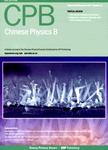Tunable deconfined quantum criticality and interplay of different valence-bond solid phases
Tunable deconfined quantum criticality and interplay of different valence-bond solid phases作者机构:Department of PhysicsBoston University590 Commonwealth AvenueBostonMassachusetts 02215USA Beijing National Laboratory for Condensed Matter Physics and Institute of PhysicsChinese Academy of SciencesBeijing 100190China
出 版 物:《Chinese Physics B》 (中国物理B(英文版))
年 卷 期:2020年第29卷第5期
页 面:52-65页
核心收录:
学科分类:07[理学] 070205[理学-凝聚态物理] 0805[工学-材料科学与工程(可授工学、理学学位)] 0704[理学-天文学] 0702[理学-物理学]
基 金:Project supported by the NSF under Grant No.DMR-1710170 and by a Simons Investigator Grant
主 题:quantum phase transitions deconfined quantum criticality quantum spin systems quantum Monte Carlo simulations
摘 要:We use quantum Monte Carlo simulations to study an S = 1/2 spin model with competing multi-spin interactions. We find a quantum phase transition between a columnar valence-bond solid(cVBS) and a Néel antiferromagnet(AFM), as in the scenario of deconfined quantum-critical points, as well as a transition between the AFM and a staggered valence-bond solid(sVBS). By continuously varying a parameter, the sVBS–AFM and AFM–cVBS boundaries merge into a direct sVBS–cVBS transition. Unlike previous models with putative deconfined AFM–cVBS transitions, e.g., the standard J–Q model,in our extended J–Q model with competing cVBS and sVBS inducing terms the transition can be tuned from continuous to first-order. We find the expected emergent U(1) symmetry of the microscopically Z4 symmetric cVBS order parameter when the transition is continuous. In contrast, when the transition changes to first-order, the clock-like Z4 fluctuations are absent and there is no emergent higher symmetry. We argue that the confined spinons in the sVBS phase are *** also present results for an SU(3) symmetric model with a similar phase diagram. The new family of models can serve as a useful tool for further investigating open questions related to deconfined quantum criticality and its associated emergent symmetries.



